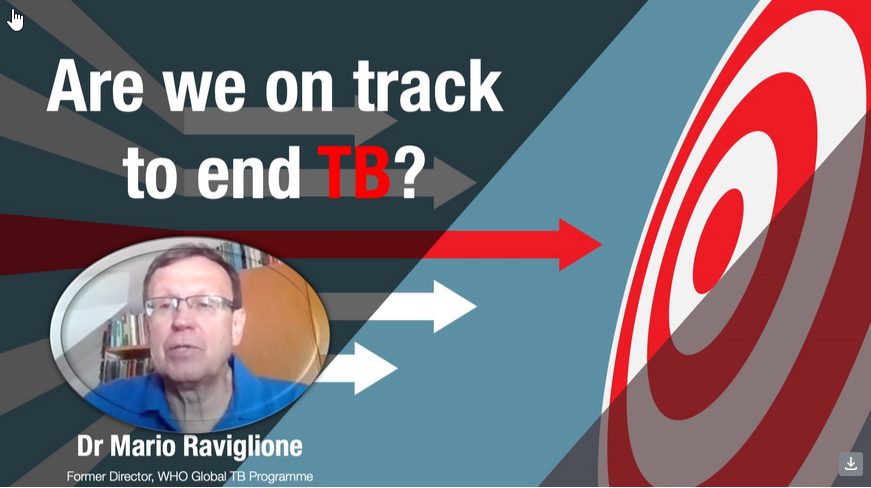Akin to a rocking chair that moves forwards and backwards without any real progress, we cannot assume busy TB programmes which may appear to have a lot of movement, to be making any real
progress - unless they are doing what is warranted as per science and evidence to end TB.
Despite having the best of evidence-backed tools to prevent, diagnose and treat TB, the latest World Health Organization (WHO) Global TB Report shows that 3 million people (out of an estimated 10.6 million people with TB) were missed in 2022.
More worrying is that of the 7.5 million people who got diagnosed of TB in 2022, only 47% were diagnosed on an upfront molecular test. In other words, more than half of those with TB were diagnosed on sputum microscopy, which significantly underperforms in diagnosing TB (it may miss 40-50% of cases). Should not we set accountability for missing TB cases even among those who take a TB test?
Despite WHO recommendation and promises by world leaders to replace microscopy 100% with upfront molecular test for TB diagnosis, the abysmally slow pace at which this transition is happening is unacceptable.
A lot of TB prevalence surveys in high TB burden countries have shown that a very large number of people are asymptomatic for TB – and TB disease in them could only be found when they were screened with an x-ray – and those with presumptive TB, were offered a molecular test diagnosis.
Thanks to science, recently we have x-rays that can be taken out of the labs. In March 2021, WHO, for the first-time, recommended the use of portable x-ray in combination with compatible AI (Artificial Intelligence)-powered Computer-Aided Detection (CAD) software solutions. In September 2021, The Lancet wrote: “All five AI algorithms significantly outperformed the radiologists.”
But when we look at high TB burden countries, ultraportable, handheld, and battery-operated x-ray machines have not been deployed for population-wide screening of TB (screening everyone, regardless of TB symptoms). Unless we screen everyone for TB – regardless of symptoms – and offer upfront molecular test diagnosis and linkage to treatment, care and support, how will we ever end TB?
Important pilots supported by the Stop TB Partnership have demonstrated in high TB burden settings the difference portable x-rays and battery operated, point-of-care and laboratory independent molecular test like Truenat has made in finding TB. But these pilots are yet to be scaled up to bend the TB curve.
Not only are we failing to find all TB, but many high TB burden nations are still using old treatment regimens that are longer, more toxic, and less effective. One month TB preventive therapy, four-months treatment for drug-sensitive TB, and six-months all oral treatment for drug-resistant forms of TB are yet to reach many people in need.
When state-of-the-art and highly accurate TB diagnostics and lifesaving TB medicines are available (thanks to scientists and people who took part in the clinical studies), how can one explain 1.3 million people dying of TB in 2022 worldwide (and 10.6 million getting newly infected in the same year)? Every TB death is a missed opportunity to save lives. Every new TB infection is a grim reminder that we could have done better.
The guiding light: WHO End TB Strategy of 2014
The latest WHO End TB Strategy was adopted by the World Health Assembly in 2014. It had set the course for ending TB. The collaborative process which resulted in End TB Strategy of the WHO had begun in 2012. By end of 2015, UN Sustainable Development Goals adopted by the world leaders had the promise to end TB by 2030 enshrined as one of the targets.
When 2014 End TB strategy got the green light, back then, WHO Global TB Programme Director was Dr Mario Raviglione, who currently is serving as Professor of Global Health at the University of Milan, Italy, where he is a founding director of the Centre for Multidisciplinary Research on Health Science, and Honorary Professor at the Queen Mary University of London, UK. While delivering a keynote address at 25thInternational AIDS Conference or AIDS 2024 Affiliated Independent Event in July 2024 organised by CNS (Citizen News Service) along with over 35 TB and HIV groups worldwide, he had said, “A significant number of International targets that we have today are still those of the WHO End TB Strategy (2014) that was approved by the World Health Assembly ten years ago”.
Dr Mario is right- rather, the truth is even grimmer: owing to the failure to deliver on some of the targets – such as achieving zero catastrophic costs by 2020, the goalpost has been shifted to 2030. But have governments also course-corrected so that zero catastrophic costs become a reality sooner than later?
In 2014 WHO End TB Strategy, governments agreed to reduce TB incidence by 80% and reduce TB deaths by 90% by 2030. More importantly, no household should suffer any catastrophic cost due to TB.
Studies done in India, which has the highest TB burden worldwide, show that more than half of catastrophic cost occurs before a person gets the correct TB diagnosis. Imagine the impact if India and other countries can make early and accurate TB diagnosis a reality – and eliminate catastrophic costs (and diagnostic delays) for all people with TB.
Dr Raviglione points out that the first-ever United Nations General Assembly High-Level Meeting on TB in 2018 also lacked ambition. Its political declaration generally called for progress on targets which were already enshrined in the SDGs or the End TB Strategy. Same happened in the second-such meeting in 2023.
Between 2018 and 2023, high TB burden countries did make some progress towards commitments made at the UN in 2018, but overall, if we are to end TB then it warrants more ambitious target-setting and stronger actions-on-the-ground.
For example, out of all the promises made by world leaders in 2018 at UNHLM on TB, they only delivered (and over-performed – thankfully) on one of the promises - the promise to provide TB preventive therapy to people living with HIV (so that those with latent TB may never get active TB disease), shares Dr Raviglione.
We are off-track on TB targets
“Where are we in terms of TB targets? We are far away – that is the point - we are really off track,” said Dr Raviglione.
TB incidence was declining in the years before the pandemic but far too slowly – miniscule to call it at best: 1.5-2% per year. Despite strong evidence from Ca Mau, Vietnam, where studies done by Dr Nguyen Bin Hoa and Dr Guy Marks et al, have shown that if we regularly screen everyone (regardless of TB symptoms), offer molecular test to those with presumptive TB, and link all those with the disease to treatment, care and support, TB rates decline by 74% over four years! In Kerala in India, TB rates declined in six years by almost 40% (as per a news report quoting Kerala’s Chief Minister).
During the lockdown due to COVID-19 pandemic, TB and other health and social services got disrupted in many places, but it is important to remember that we were not on track to end TB even before the pandemic, and the lockdown only aggravated the challenge.
Drug-resistant TB rates have not declined over the years (about half a million new infections every year). In 2022, an estimated 410,000 people got infected with drug-resistant TB disease – out of which a little over one-third, were diagnosed and put on treatment. Is this acceptable if we are to end TB?
Dr Raviglione underlines dearth of financing for TB programmes. It was expected that US$ 13 billion would be made available for a five-year period ending 2022 to fully fund the fight against TB, but less than half of this amount (US$ 5.5 billion) came through. TB research funding gap is grim too with only half of what is required being made available.
The new Global Plan to End TB 2023-2030 of the Stop TB Partnership is more ambitious, says Dr Raviglione. It envisages US$ 20 billion per year financing for TB and US$ 5 billion (up from US$ 2 billion) for TB research if we are to end TB by 2030. “This is fairly a small amount if we are to compare with financing for COVID-19, HIV or other diseases,” said Dr Raviglione.
Accountability missing in TB response
Even though TB is finally recognised as a priority for action, yet accountability for action (or inaction) is seldom there, he said.
It is an important reminder for all of us that Dr Raviglione’s team had led the organising of the first-ever high-level ministerial meeting to end TB in Moscow, Russia in November 2017. Among other outcomes, one of the most promising ones was: multistakeholder accountability framework. The call for multistakeholder collaboration was never at this decibel ever before.
It is among the fundamentals if we are to end TB to ensure 100% upfront molecular diagnostics for all those with presumptive TB worldwide – along with best of treatments, and 100% social benefit and social protection.
“Without universal coverage everywhere, and without social protection, we will never ever get rid of this disease,” said Dr Raviglione.
“TB reached an unprecedented political visibility – this is undisputable – but this is clearly not sufficient,” he said. “Citizens have to hold governments to account for a disease that is preventable and treatable/ curable.” It also implies that governments should tap into domestic resources for sustainable health financing. “Poorest countries in the world that are not likely to mobilise necessary domestic resources in the next few years, should get topmost priority for external funding,” said Dr Raviglione.
Whole of government and whole of society approach
TB response is dependent or interdependent on so many other determinants - HIV, nutrition, non-communicable diseases like diabetes, tobacco control, alcohol control, air pollution, and so many others.
“Community leadership and engagement remains fundamental to maintaining political pressure to advocate for improving the TB response,” said Dr Raviglione. “We need to build and strengthen multistakeholder response as well as multistakeholder accountability when it comes to TB.” Community-led monitoring can help enhance TB programme outcomes.
He shared an important example: 100% social protection for urban poor as part of promises enshrined in SDG11, which includes providing proper housing, is so key – if the relevant government sectors deliver on this target it will have a cascading positive impact on TB response as well.
It is the intensity of doing ‘what-we-know-works’ that has diminished, rightly said Dr Raviglione.
Is 2014 WHO End TB Strategy still adequate or we need to go back to the drawing board? “The pillars of WHO End TB Strategy are still very valid, but we do need to fortify multisectoral contributions in a very concrete way. Multi-sectoral approach should be operationalised at all levels – especially national or subnational levels where government ministries, departments and programmes, and other stakeholders synchronise their efforts towards addressing poverty, hunger and malnutrition, lack of housing, or other issues,” said Dr Raviglione.
Importance of whole of government and whole of society approach can never be overemphasised when it comes to addressing the deadliest of infectious diseases – TB. Time to unite and act is now.

 Importance of whole of government and whole of society approach can never be overemphasised when it comes to addressing the deadliest of infectious diseases – TB. Time to unite and act is now.
Importance of whole of government and whole of society approach can never be overemphasised when it comes to addressing the deadliest of infectious diseases – TB. Time to unite and act is now.










.jpeg)


_(1)_(1)_(1).jpeg)
.jpeg)
.jpeg)
.jpeg)








.jpeg)
.jpeg)

.jpeg)


.jpeg)